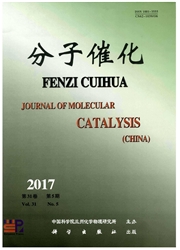

 中文摘要:
中文摘要:
一个新奇合成电极被一起压 Co3O4 和石墨构造,它在 electro-Fenton-like (EFL ) 被用作阴极系统。Co3O4 的差的电子运输特征被合并石墨克服。在 situ 氢氧根激进分子的电镀物品催化的产生(浥
 英文摘要:
英文摘要:
A novel composite electrode was constructed by pressing together Co3O4 and graphite and it was used as the cathode in an electro-Fenton-like (EFL) system. The poor electron transport characteristic of Co3O4 was overcome by incorporating graphite. In situ electro-catalytic generation of hydroxyl radicals (·OH) occurred at high current efficiencies from pH 2-10, extending the traditional Fenton reaction pH range. Cyclic voltammetry and AC impedance spectrometry were used to characterize the composite electrode. The ability of the EFL system to degrade organic compounds was investigated using sulforhodamine B (SRB) and 2,4-dichlorophenol (2,4-DCP) as probes. Decoloration of SRB (1.0×10-5 mol/L) was complete (100%) in 150 min and SRB was effectively degraded from pH 2-10. The decomposition of SRB was studied using Fourier transform infrared spectroscopy (FT-IR) and total organic carbon (TOC) analysis and results indicated that the final degradation products were carbon dioxide, carboxylic acids and amines. The EFL system also decomposed 2,4-DCP and the degradation was 98.6% in 240 min. Electro-catalytic degradation of SRB occurs by a ·OH mechanism. After 5 times reused, the degradation rate of SRB did not significantly slow down. The electrode shows excellent potential for use in advanced oxidation processes (AOPs) used to treat persistent organic pollutants (POPs) in wastewater.
 同期刊论文项目
同期刊论文项目
 同项目期刊论文
同项目期刊论文
 BiOBr Activation by UV and Visible Irradiation: A Telling Difference in Oxygen Source during Photoca
BiOBr Activation by UV and Visible Irradiation: A Telling Difference in Oxygen Source during Photoca Degradation of ciprofloxacin in aqueous bismuth oxybromide (BiOBr) suspensions under visible light i
Degradation of ciprofloxacin in aqueous bismuth oxybromide (BiOBr) suspensions under visible light i Degradation of Microcystin-LR in water: Hydrolysis of peptide bonds catalyzed by maghemite under vis
Degradation of Microcystin-LR in water: Hydrolysis of peptide bonds catalyzed by maghemite under vis Photocatalytic properties of hierarchical BiOXs obtained via an ethanol-assisted solvothermal proces
Photocatalytic properties of hierarchical BiOXs obtained via an ethanol-assisted solvothermal proces Moderate valence band of bismuth oxyhalides (BiOXs, X = Cl, Br, I) for the best photocatalytic degra
Moderate valence band of bismuth oxyhalides (BiOXs, X = Cl, Br, I) for the best photocatalytic degra Bismuth oxybromide promoted detoxification of cylindrospermopsin under UV and visible light illumina
Bismuth oxybromide promoted detoxification of cylindrospermopsin under UV and visible light illumina Comparing the degradation of acetochlor to RhB using BiOBr under visible light: A significantly diff
Comparing the degradation of acetochlor to RhB using BiOBr under visible light: A significantly diff Moderate valence band of bismuth oxyhalides (BiOXs, X=Cl, Br, I) for the best photocatalytic degrada
Moderate valence band of bismuth oxyhalides (BiOXs, X=Cl, Br, I) for the best photocatalytic degrada Heterogeneous degradation of toxic organic pollutants by hydrophobic copper Schiff-base complex unde
Heterogeneous degradation of toxic organic pollutants by hydrophobic copper Schiff-base complex unde 期刊信息
期刊信息
